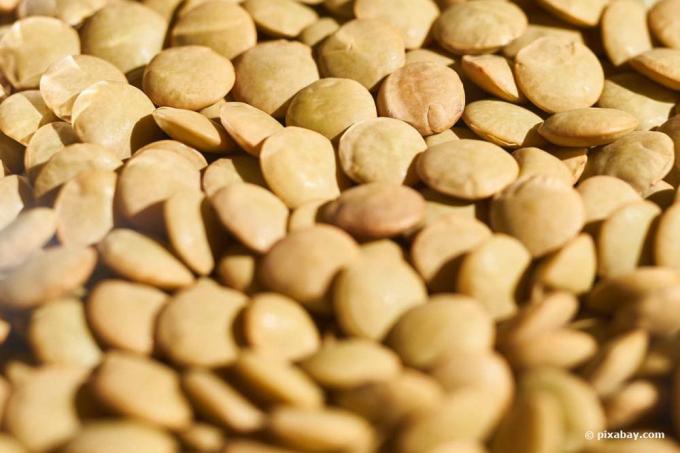
table of contents
- Types of lenses
- Distinction
- 1. By size
- 2. By color
- Popular types of lentils
- Alblinsen (Alb Leisa)
- Anicia lens
- Beluga lens
- Mountain lenses
- Berry lentil
- Castelluccio lens
- Chateau lens
- Pardinal lenses
- Puy lentils
- Plate lenses
- use
Gone are the days when lenses had a poor man's image. For several years now, the flat legume has been experiencing a renaissance in our kitchens and has been more popular than ever since then. And not only gourmets and vegetarians appreciate the variety of their fine flavors. We have put together popular types of lentils for you, including a little product knowledge.
Types of lenses
The lenses (botanically Lens) only include six different types of lenses. Two of these types of lenses, namely Lens nigrans and Lens orientalis, count as ancestors of the kitchen lens (Lens culinaris). Many only know the large plate lentils that are often used for stews. There are over 70 varieties worldwide, some of which are only grown in small quantities in very regional areas.
Small product knowledge
Lentils are one of the oldest cultivated plants on earth. The home of the legumes is believed to be in Asia Minor and Egypt, where the herbaceous plant was probably cultivated around 10,000 years ago. And in Germany, too, the lentil was a typical field crop around 100 years ago, especially in the Swabian Alb. The Lens culinaris finds perfect conditions here, because it likes barren soils and warm, dry climates. What she cannot tolerate is repeated cultivation in the same area. It demands a break from cultivation after at least six years - a difficult undertaking in our present day Monocultures oriented agriculture.
by the way: Did you know that the lentil is one of the legumes that enrich the soil with nitrogen?
Distinction
Because of the many different cultivars and variations, one differentiates kitchen lenses preferably according to color and size. In terms of shape, the individual types of lenses hardly show any major differences. Most seeds have their characteristic, flat oval shape. A few varieties are also spherical in shape.
1. By size
Small-seeded lentils (mignon lentils)
- 3 to 5 mm in diameter
- Seed color: green, light red, brown to black
- more flowered than large-seeded varieties
- higher seed yield
- more tasteful due to the high proportion of peel
Sugar lentils
- Diameter: 4 mm
- noticeably bulbous shape
Central lenses
- Diameter: 4.5 to 6 mm
Large seeded lentils
- Diameter: 6 to 7 mm
- Minimum size for plate lenses
- Main growing area: Mediterranean area
by the way: Lentil seeds that are more than seven millimeters in diameter are called giant lentils.
2. By color
Green lentils
This is the name given to the fresh, unpeeled lentil seeds with a yellowish-green core that turns brownish over time. They come in a wide variety of shades, from green slate to pale or dotted green tones to a touch of blue or black.
Brown lentils
Brown lentils are usually green lentil seeds that had been stored for a longer period of time and were still olive green shortly after they were harvested. The taste hardly suffers from the natural discoloration. In some cases the cooking time can be a little longer.
Yellow and red lentils
The yellow and red lentils are not their own varieties, but peeled lentil seeds. The color of the shell can be completely different. The red variants, which are relatively small with a diameter of three to four millimeters, stand out have a sweet taste and are particularly popular in Turkish and Indian cuisine spread. The yellow colored kernels are usually somewhat larger and have a creamy consistency when they are cooked. They boil to a pulp quickly and they lack the typical lentil aroma.
Popular types of lentils
Over 70 different varieties of Lens culinaris are grown worldwide. 50 of them come from the Indian subcontinent. In Germany, the choice is not that big. A colorful variety is now available in stores. Their name often comes from the respective growing area.
Alblinsen (Alb Leisa)
Lentil cultivation also had a long tradition in Germany. Until the 1950s, the main growing area for legumes in German-speaking countries was Swabia. However, since the cultivation was very time-consuming and labor-intensive, it could no longer withstand the cheap exports from Turkey, India and Canada and eventually died out. Around 2006, the albl lentils were rediscovered by chance in the Russian genetic database for crops.
Alb-Leisa I (Späths Alblinse 1)
- Shell: light green to ocher colored
- Core: yellow
- Size: 4 to 5 mm
- Floury boiling
- Taste: slightly nutty
Alb-Leisa II (Späths Alblinse 2)
- Color: light green to beige, partially spotted or marbled
- Interior color: yellow
- Size: 3 to 4 mm
- waxy
- Taste: aromatic to spicy

tip: In addition to the two main varieties, there is also a third, small-seeded alblentine variety, which is marbled green or black and which cooks very firmly.
Anicia lens
A popular variety in France is Alicia green lentil. It is similar to the Puy lentil and is also grown in the same region, Auvergne. Characteristic of this green lentil specialty is the thin shell, which makes it particularly fine and delicate.
- Bowl: marbled green
- yellow to greenish yellow inside
- Size: around 4mm
- waxy
- Taste: particularly nutty
Beluga lens
The small-seeded beluga lentil is one of the finest types of lentil. Since the black lentil is reminiscent of beluga caviar in appearance, it is also called vegetarian caviar or caviar lentil among gourmets. The black legumes are believed to come from North America. Because the bushy plant needs a moderate, mildly warm climate, which is why large-scale agricultural cultivation is only possible in certain regions of the USA and Canada.
- Shell: glossy black
- Core: yellowish
- Size: 2 to 3 mm
- waxy
- Taste: delicately nutty, like roasted chestnuts

Mountain lenses
There is no special type of lens to be found under the term mountain lentils. Mountain lens is a collective term for different varieties from the mountainous regions of the world. Therefore, the products offered can differ greatly from one another. What they all have in common is that they are cultivated at least 700 meters above sea level. Mountain lentils are a bit smaller and are therefore considered more aromatic than plate lenses.
Berry lentil
These Lens culinaris seeds take their name from the Berry region near Paris where they are grown. This is why this type of lentil is often referred to as the green berry lentil.
- Shell: beige with noticeable dark blue to greenish markings
- very thin, delicate skin
- Interior color: light to olive green
- Size: 3.5 to 5 mm
- conspicuously round
- waxy
- Taste: aromatic to spicy, reminiscent of chestnuts
Castelluccio lens
Castelluccio is a small village in the Monti Sibillini National Park in Umbria. The lenses grown there at an altitude of around 1400 meters are considered to be the finest in Italy. Probably also because they are traditionally cultivated only to a very small extent and the harvest is only around 100 tons per year.
- Skin: very different (yellowish, pink, red-brown or greenish)
- Core: red
- Size: 4 to 5 mm
- waxy
- Taste: earthy to nutty
Chateau lens
A specialty from the ranks of the small and therefore very aromatic lentil specialties is the in French Champagne cultivated chateau lentils, which are therefore also known as Champagne lentils on the market is.
- Skin: light brown to reddish brown
- Interior color: red
- Size: 4 to 5 mm
- waxy
- Taste: floury and nutty
Pardinal lenses
Pardinal lentils have been grown in northern Spain according to an old tradition for over 800 years. The name Pardino comes from the Spanish word "pardo" and means nothing other than "brown". Since the early 1980s, the pardine lens has also been cultivated in the USA because the lens is very resistant and robust. We also know pardine lentils as brown lentils and are therefore often confused with the similar-looking plate lentils.
- Shell: light brown, reddish brown or gray brown with black dots
- bluish marbling
- Core: strong yellow
- Size: 4 to 5 mm
- waxy
- Taste: aromatic, slightly nutty
Puy lentils
The particularly exquisite types of lentils include berry and beluga lentils as well as green puy lentils, which grow on the volcanic soils of the French Auvergne. Despite the thin skin, the lentils have a very firm consistency.
- Skin: light brown, red brown to brown gray
- Core: yellow
- Size: 3 to 4 mm
- waxy
- Taste: nutty, slightly peppery

by the way: Only if the lens comes from the French Auvergne, it can be called "Le Puy". The same variety from another growing area is simply called Green Lentil.
Plate lenses
With a diameter of around seven millimeters, the plate lens, popular in Germany, is one of the large types of lenses. It is suitable for all types of lentil dishes. In the trade, plate lenses are also offered under the name Green Lenses or Trojas Lenses. Disc lentils are colored a light olive green immediately after harvest. After a long period of storage, they then turn yellow-brown to brown. The change in color does not affect the taste or cooking properties.
- Skin: greenish, yellow to brown or olive green
- Interior color: yellow
- Size: 6 to 7 mm
- floury-creamy consistency
- Taste: mild to earthy
use
Depending on their size and color, lentil seeds have very different cooking properties. Because some varieties are rather floury and cook quickly. However, they are great for soups, stews, and spreads. Others, on the other hand, keep their shape and are still firm to the bite even after a long cooking time. These can therefore be used well for salads. As a rule of thumb, the larger the type of lentil, the faster it overcooks. Since the flavors mainly come from the peel, unpeeled seeds are more intense in taste than the bare kernels.






